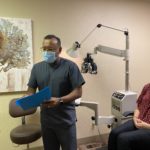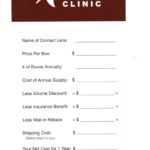
Dr. Patel shares the findings of his exam with a member of his support staff. Dr. Patel says that he and his staff educate patients about why it’s in their self-interest to buy contact lenses from their practice, rather than from an online retailer.
By Raj Patel, OD, FAAO
August 24, 2022
Effectively competing with online retailers makes all the difference to a practice’s ability to provide patients with a high level of service while growing profitability. We implemented a system that changed how we present and sell contact lenses, which significantly boosted our contact lens sales.
Prior to implementing a consistent system, we were averaging 3.8 boxes sold per contact lens exam for the preceding six-month period. After implementing our new system, we are consistently averaging 5.41 boxes sold per contact lens exam when measured in rolling six-month periods.
Here are the details on the system that enabled us to achieve this.
Telling Patients What’s In It For Them In Buying from Us
About 10 years ago we recognized in our practice that consumers tend to view transactions like a seesaw. On one side is our money, on the other side is the question of what’s in it for me (WIFM). We want to perceive the weight of WIFM as greater than the dollars we spend for it. When we can do that for our patients, the patient (consumer) feels like they have obtained value in the transaction, and is more likely to purchase from us. WIFM is the question, “If I choose to buy my contact lenses from you, what do I get?” You could say, in response, that it’s the many services and cost-savings you offer around the sale.
Emergency trial pairs, volume in-house savings for a year supply, manufacturers’ rebates, 20 percent off plano sunwear with an annual supply, free shipping to home or work, and free exchange of unopened, unmarked boxes, are reasons my staff and I give patients in response to the question of why they should buy from us. These “extras” we offer patients cost us little while making it much more likely they will choose us over an online competitor. The perceived value of these services is high.
If you lead with the price in trying to persuade patients to buy from you, you’re racing to the bottom, as there will always be someone who will charge the patient less. Educating the patient about the many value-adds is much better. When you can show patients what they get when they buy from you, and then show the lowest per-box price you can offer, you greatly boost contact lens supply capture rate.
Training Staff to Present Value Proposition
Our staff has been trained to quickly and concisely explain the benefits of buying contact lenses from us, emphasizing what they get from us, but won’t get when buying online. In the exam room I talk to patients about the opportunity to buy an annual supply, and I have the contact lens technician go over the value-adds in the exam lane after the exam, before they get to the reception desk.
We worked with one of our contact lens partners and our contact lens distributor many years ago to help us train staff. We set aside two hours a week for four weeks to work on presenting our value proposition. The reps helped our entire staff understand how we help our patients when we can meet their needs here. We worked on scripts, what hand-offs should look and sound like, created a value proposition card, which we fill out before the exam is finished, and reviewed the idea of “assumption of sale.”

Dr. Patel uses this form to break down the cost for patients to buy from his practice, showing exactly why, financially, the patient should purchase in his office instead of from an online retailer.
We did many staff meetings that included role-play exercises. We would have someone act as the patient, walk them down the hall to check out, demonstrate when during the exam we need to pull the contact lens boxes and have the lenses packaged up at the front desk before the patient gets there.
We had to teach our staff that in order for these people to see well, they will need to buy more contact lenses. They can buy them anywhere, so let’s give them good reasons to choose us. We had to look at our process to see who on the team could fill in the value proposition cards before or during the patient exam, so we were not scrambling at the end to do so. We role-played what the language would sound like, the idea of assuming the sale was going to happen until they told us no, and asking, “How would you like to pay for this today” versus “How many boxes would you like?”
Talking Like We Assume the Patient Will Buy
We assume our patients need a year supply of contact lenses, our tech pulls them from our inventory, and places it in a nice branded bag, with rebate and contact lens solution (if not daily disposable lenses) at the front counter where the patient sees it.
The reception desk says something like, “Dr X has prescribed Y lenses for you. We have them here for you to leave with today.” They review the pricing with the patient: “Typically a year supply of your lenses is A. However, with our our office’s volume savings, and your rebate and insurance coverage, your actual cost for a year supply is B. Today you will pay C, and get X back after you send in this rebate. Then you are all set until next year. How would you like to pay for that?”
Emphasizing How Convenient it Is to Buy from Us
People will make a decision based on convenience, even if it’s a few dollars more, if they like you, you make it easy for them, show you care and they know you will take care of them after the sale (rebates, trials, box exchanges, etc). Make it super-easy for the patient, and they usually will stay. We have to remember that what sets the patient experience is primarily the staff and our processes. So, if you can work at creating smooth processes that save the patient time, they appreciate it and remember how efficient your office was. This leads to more positive reviews that potential new patients see, and captured contact lens sales.
Other Articles to Explore
We realized we needed to give the patient the opportunity to leave with their boxes today, and if not, we needed to give them every reason to order here before leaving. Having a system where we can either have patients leave the same day with the most common Rxs, or supply them with trials in their Rx and ship lenses to their home, makes it so they don’t have to do any additional work to get their lenses.
We keep our most frequently prescribed daily disposable and monthly disposable lenses in stock in our office, pull the lenses from inventory and have them waiting at the front desk in a nicely packed presentation bag, with rebate, and our value proposition card as soon as the patient gets to the check-out desk. The card breaks down the per box cost after rebates, insurance and in-house volume savings on one side. It shows zero shipping cost. The other side has information about what the patient gets from our office when they buy an annual supply (emergency trials, saving on sunglasses, exchange if unmarked and unopened boxes, etc). When the patient sees the supply of boxes in front of them, ready to go, we find that the the perception of higher cost versus the convenience of walking out the door, and not having to think about CL for a year and saving the associated time, generates increased sales.
Presenting Lowest Annual Per-Box Cost First
We have found that presenting annual supplies with the lowest annual per box cost is more acceptable than seeing the larger annual number, especially with daily disposable multifocals and torics. Our value proposition card includes a breakdown of per box price / # boxes needed annually / cost of annual supply / internal volume savings / insurance benefit / manufacturer rebate / shipping cost $0. This gives us net cost for one year and the last line is net cost per box.
When patients see that their net annual supply is so low, and especially, see the per box number so low after all the savings measures, we are able to keep a high proportion of sales in-house. Patients who choose to walk, take the card with our cost break down and service benefits with them. We make it a point for the reception desk to show the patient what the per box net price would be if they purchased from us. Sometimes we get calls back to order from us shortly after the patient leaves. This would not happen if we did not educate the patient so well on the many benefits they get from purchasing from us and how we help them save on the total cost of their lenses.

Raj Patel, OD, FAAO, Diplomate, American Board of Optometry, is a partner with Vancouver Vision Clinic, which has two locations in Vancouver, Wash. The practice is one of CooperVision’s Best Practices. To contact him: raj.patel@vancouvervision.com

























